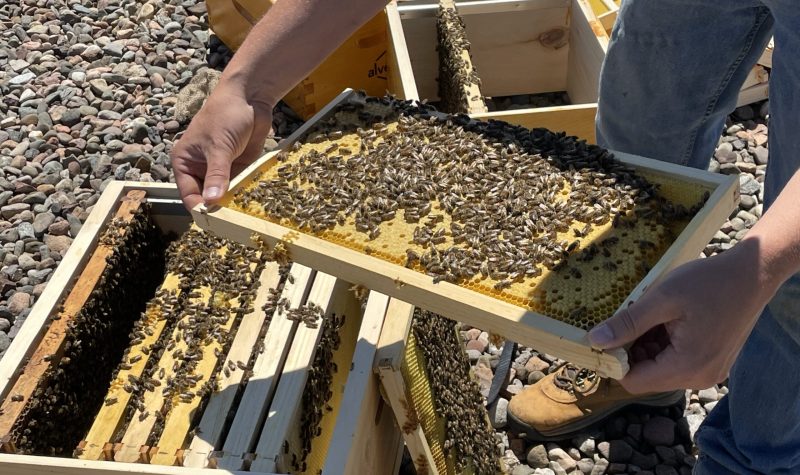Halifax Shopping Centre is buzzing with excitement as it welcomes its latest black and yellow tenants occupying the mall’s rooftop: a hive of honeybees.
Thanks to a partnership with urban beekeeping group Aveole, the roof is now home to about 16,000 honeybees. Aveole partnered with the centre a year ago for this project and is providing the centre with a hive and a bee-keeper. The bees arrived to their new location mid-June and will be staying in the mall long term.
Marketing Director of Halifax Shopping Centre Stephanie Schnare said since the public will not have access to the roof for safety reasons, she found another way to share the experience with shoppers.
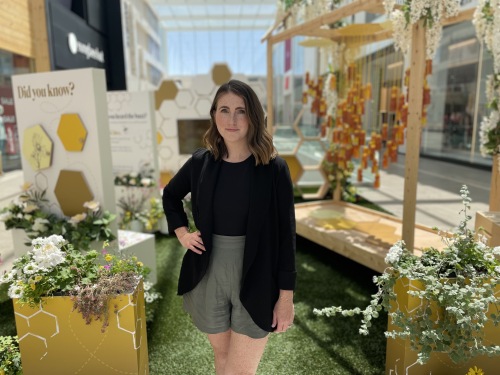
Stephanie Schnare is the marketing director of the Halifax Shopping Centre, she is standing in front of the mall's latest honeybee indoor installation. Photo by Sara Gouda.
“We created an indoor mall installation that shares a lot of the interesting facts about bees. We installed it in the shopping centre so people can watch and interact, take photos with it, as well as experience some of our upcoming events, all in the hopes of just understanding more about bees and their important role in the ecosystem,” Schnare said.
The display includes a honey-themed hexagon wall, selfie stations, a greenhouse with about 100 bottles of hanging honey and television infographics with honeybee facts.
This project was done through the shopping mall's program Always Consider Tomorrow (ACT) which focuses on environmental topics such as sustainability and people’s environmental impact.
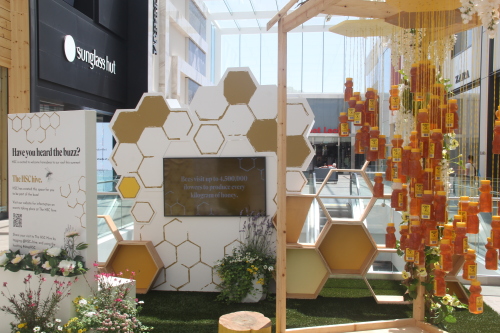
The mall's indoor installation is a way for shoppers to learn about honeybees. Photo by Sara Gouda.
“We’re looking for a way to support our community in a long-term manner as part of that program. Our roof is fairly underutilized and it's a very safe area, which is ideal for the bees,” Schnare said.
The mall also partnered with Halifax Seed and is giving away 1,000 packages of their local Eastern wildflower seed mix.
“Also in September, when we harvest the honey, we'll be donating it to Feed Nova Scotia.”
Learning about honeybees with beekeeper William Adamski
Aveole bee-keeper William Adamski said their main goal is to reconnect people with nature and educate them on the importance of pollinators in the environment.
“It’s very important because of the declining numbers of pollinators worldwide" Adamski said. "The honeybee plays a main role in the food chain: about a third of the food that we consume each day is pollinated by honeybees like nuts, seeds, fruits, berries and some vegetables.”
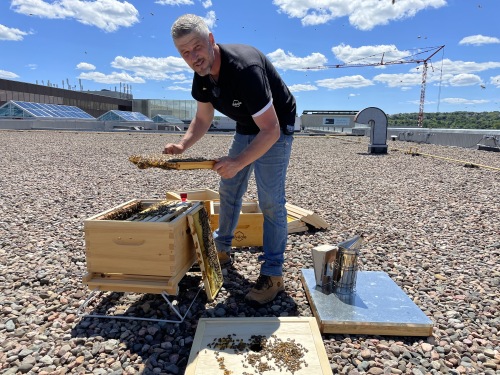
Aveole beekeeper William Adamski routinely checks on the honeybees every two weeks. He maintains the hive, sets it up and assesses them to make sure everything is fine. Photo by Sara Gouda.
Adamski said the beehive colony consists of three members: drones, which are the males, worker bees, which are the females, and one queen.
Honeybees can forage up to five kilometres away in search of nectar and pollen to bring back to the hive. Adamski explained the process of how the queen runs the beehive and lays eggs.
“When the queen takes her virgin flight; this is when she first emerges, she will meet with up to 20 drones. When she meets with 20 drones, she'll have enough sperm to last your lifetime, she'll have about five million to six million sperm, but the size of a pinhead.”
After that, the queen would return to the colony and starts laying eggs. A healthy queen can lay up to 2,000 eggs a day.
“What's magnificent is the queen decides which egg is going to be male or female," Adamski said. "And if she fertilizes the egg, it's going to be a female. And if she doesn't, it's going to be a male.”
The queen controls everything in the hive through odour and movement by giving off different pheromones. She gives off different pheromones for reproduction and foraging.
“Bees also use movement" Adamski said. "I've opened up frames before and pulled them out and saw them doing the waggle dance. That's a famous bee dance where they'll be telling the other colony members that they found a really good spot and where it is, and the dancing is them showing their excitement, a magnificent way of communicating.”
The majority work in the beehive is done by the worker bees which are the females, their daily tasks include forging, tending to the young, pampering and feeding the queen.
The drones travel to mater with other virgin queens from different colonies, and that’s how the cycle works, according to Admaski.
Bees also produce different flavours of honey depending on the flowers they feed on. Depending on what kind of flowers are in the area and what the foragers bring back to the hive, the nectar and pollen sources are what differentiate honey flavour and colour.
“There was a colony that was exclusively feeding on buckwheat. They were feeding on rich sources of nectar and bringing that back and so the honey they produced was very dark. It tasted like molasses, that was probably by far my favourite.”
To prevent being stung, Adamski advises people to keep a short distance from bees, be gentle and avoid swatting at them.
Honeybees are also docile, and can have their mood affected by the weather. When it’s sunny they are glad to be out of their hive, but prefer to stay indoors when it’s raining.
“When this beehive is in good condition with a good population, we could see anywhere up to 30 to 60 pounds of honey near harvest time, which is probably near the end of the summer, early fall.”
Some ways people can protect the honeybees from home is by planting some wildflowers around their house. Honeybees enjoy herb flowers because of their rich source of nectar. Also growing vegetables and herbs in your garden can attract pollinators, said Adamski.
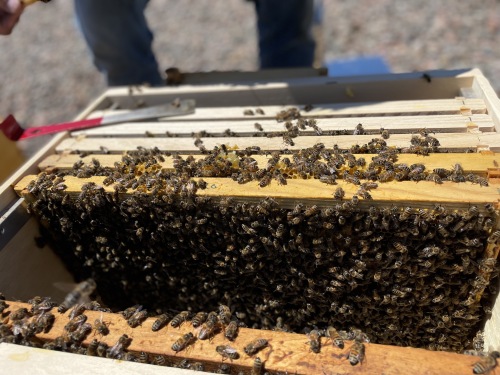
Honeybees produce different flavours of honey depending on the flowers they feed on. This hive can produce 30 to 60 pounds of honey near harvest time. Photo by Sara Gouda.
Listen to the full interview below:


